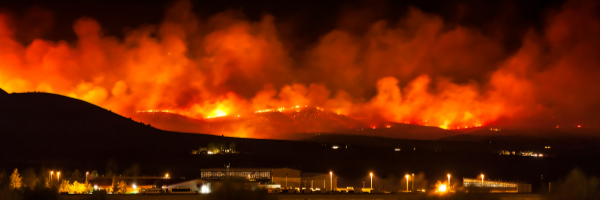
Wildfires can be devastating, engulfing everything in their path and posing a significant threat to homes and lives. With climate change intensifying fire seasons, it has become more important than ever to take proactive measures to protect our homes from potential wildfires. There are several practical steps and strategies to safeguard your home and family from the destructive force of wildfires.Sh
1. Create Defensible Space
Creating a defensible space around your home is one of the most effective ways to reduce the risk of wildfire damage. Clearing flammable vegetation and debris around your property will create a buffer zone, slowing the spread of the fire towards your home. Here’s how to do it:
- Trim Trees and Shrubs: Regularly trim branches, especially those within 15 feet of your home. This prevents fire from jumping from trees to your house.
- Clear Vegetation: Remove dry grass, leaves, and other flammable materials from your yard.
- Maintain Your Lawn: Keep your lawn well-watered and mowed regularly to reduce fuel for wildfires.
- Create Fuel Breaks: Consider adding non-flammable materials, such as gravel or rocks, to separate your home from vegetation.
2. Fire-Resistant Landscaping
Choose fire-resistant plants for your garden to decrease the risk of ignition. Opt for plants with high moisture content, low resin content, and those that don’t accumulate dead leaves. Some fire-resistant plants include deciduous trees, aloe, yucca, and succulents.
3. Install Ember-Resistant Vents
Embers from wildfires can enter your home through vents and spark fires inside. Installing ember-resistant vents can prevent this from happening. These vents have fine mesh screens that keep embers out while allowing air to flow.
4. Use Fire-Resistant Building Materials
When constructing or renovating your home, use fire-resistant building materials whenever possible. Class A fire-rated roofing, non-combustible siding, and tempered glass windows can significantly reduce the risk of your home catching fire during a wildfire.
5. Maintain Your Roof and Gutters
Regularly inspect and maintain your roof and gutters. Remove dead leaves, pine needles, and debris that can easily catch fire. Consider installing gutter guards to prevent debris buildup.
6. Keep Emergency Supplies Ready
Create an emergency kit that includes essentials like first aid supplies, a flashlight, batteries, non-perishable food, water, and important documents. Keep this kit easily accessible so you can grab it quickly if you need to evacuate.
7. Develop an Evacuation Plan
Plan and practice an evacuation route with your family. Designate meeting points and ensure everyone knows how to leave the area quickly and safely. Stay informed about wildfire alerts and warnings from local authorities.
8. Install Sprinkler Systems
Consider installing an exterior sprinkler system to wet the perimeter of your home during a wildfire. This can create a moisture barrier and help protect your home from embers.
9. Stay Informed
Pay attention to weather forecasts and wildfire updates in your area. Many regions have apps and websites that provide real-time information about fire conditions and evacuation orders.
Conclusion
While it’s impossible to completely eliminate the risk of wildfires, taking proactive steps to protect your home can significantly reduce the potential damage. By creating defensible space, using fire-resistant materials, and staying informed, you can safeguard your home and family from the threat of wildfires. Remember, preparedness is key, and every effort you make counts towards ensuring the safety and security of your loved ones and your property.

























































